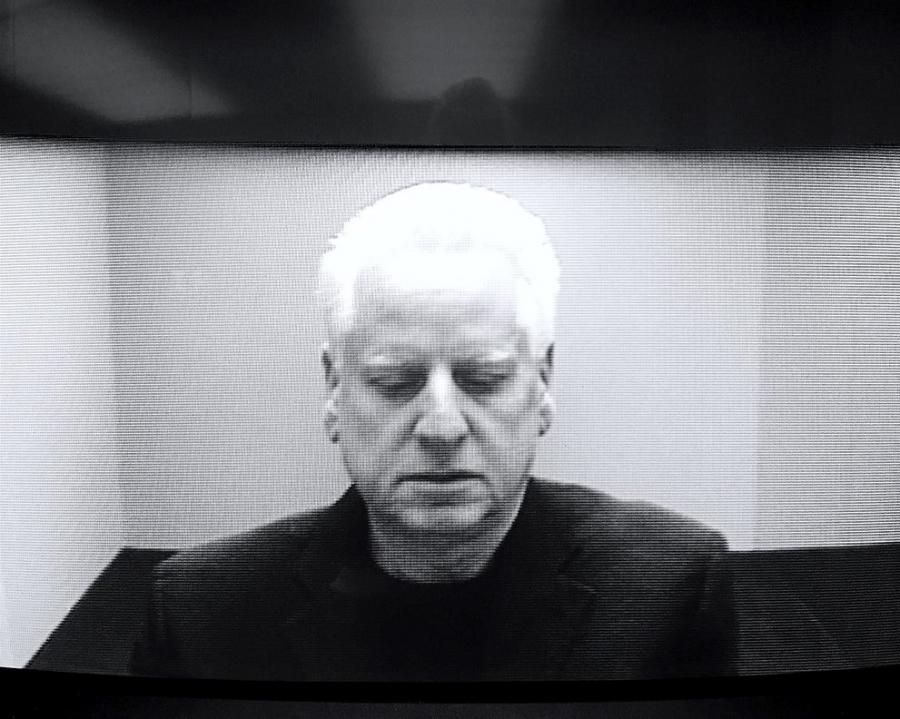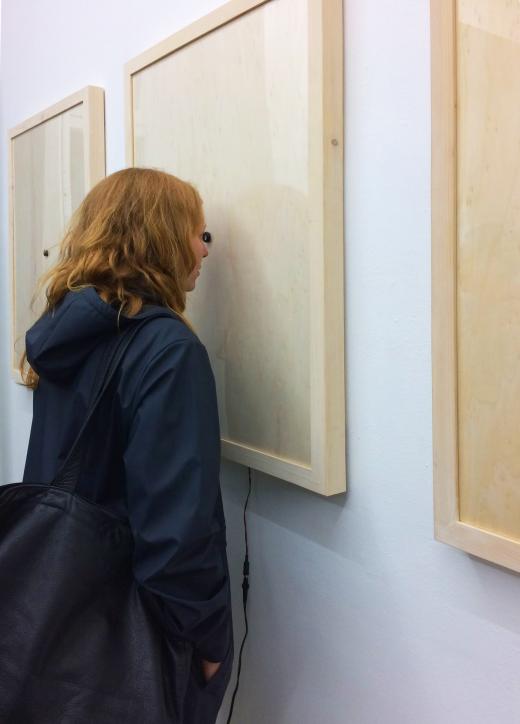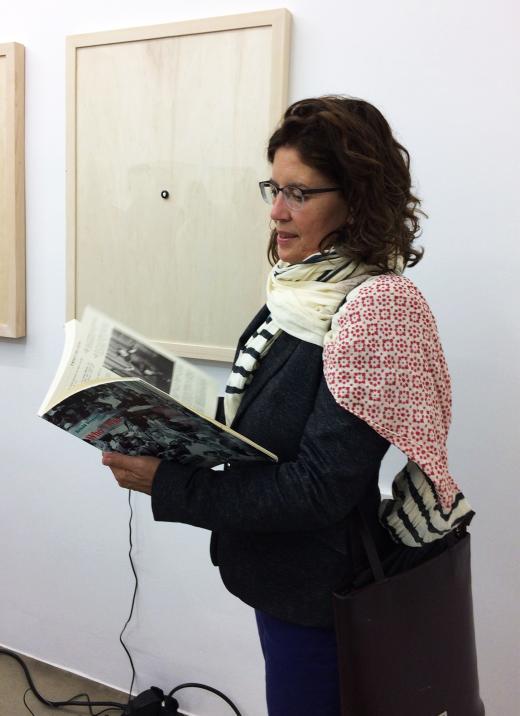Have you met... Arnold Dreyblatt
Have you met... Arnold Dreyblatt

For its 19th edition of "Appropriating Language" series, organised in partnership with the Berlin Art Week, Manière Noire shows an installation by the media artist and composer Arnold Dreyblatt. We spoke with Arnold about his ongoing show "Replica" and a number of upcoming projects, as well as his decades-long presence in the art scenes of New York and Berlin.
Can you tell us more about your piece, "Replica", currently displayed at Manière Noire?
"Replica" is one of a series of works in which micro-image storage techniques are contrasted with the burocratic process of data destruction or obliteration. Our dilemma is that we are trapped in a dialectic of saving and loss, finding and disapearance. Microfilm and microfiche are both relatively stable document archiving technnologies, in comparison to the digital, and they are here presented as unseen behind framed pseudo-artworks with peepholes. We peer into a lens and aparatus for viewing the text, which was itself developed as a hand-readable microfiche device – developed for observation by the East German intelligence services. Through intensive magnification, we read administrative texts on the "norms" and "standards" for intentional disapearance of data. These are all themes that I have dealt with in related works.
What are you mainly concerned with in your art practice in general?

My artistic practices have been realized in a diverse variety of formats and media contexts over the years, such as music composition and sound art, contemporary opera, performance as mass public readings, media installation with digital media, and artistic research projects. More than thirty years ago, I began an artistic project which is at its core text-based and which examines and visualizes “found” historical source materials and original archival documents. During a process of de- and re-constructing these texts, the focus of my work has broadened from an original interest in specific European historical dimensions in order to consider the subject of archiving and storage itself, how we “write” and store our histories and memories, both as an individual and as a culture. In this body of work I have attempted to examine the institutions (the libraries, museums, and archives), the technologies (both digital, and paper) and which methodologies and processes (life writing, biography, history, classification) are in use. In installations and performative works, I have attempted to visualize and sound the dormant files lying on dusty shelves in the archival instututions – a political category which regulates and controls access to our identities and histories.
Can you introduce us to your background and the beginnings of your art carreer?

Images 1-3: From the opening of "Replica" by Arnold Dreyblatt, September 8, 2017 @ Maniere Noire. © Margot Schumacher
My origins are in the American Media-Art landscape of the 1970's where I had developed an interest in electronic music and image. From 1974–75, I studied experimental film and video at the Center for Media Study at the State University at Buffalo, N.Y. There I was exposed to both to the early developments in video art and to an extensive history of experimental music and sound. I participated in workshops with composers Morton Feldman, Pauline Oliveros and John Cage. Later, I studied with Alvin Lucier at Wesleyan University, where I received a second MA. Having been born in New York, after my studies I returned there during an extremely stimulating time, in which the visual and performing arts where in much deeper contact than they have ever been since, and this has greatly influenced my own interdiscplinary practice since that time. My recent performative archival project on the legendiary "Black Mountain College" (which began with an invitation from the Hamburger Bahnhof in Berlin in 2015), resonated with my experiences in the New York downtown art scene in the 1979's and which had its antecedents in the earlier interdisciplary nature of education at Black Mountain.
You also teach as a professor at the Muthesius Academy Of Art & Design in Kiel (Muthesius Kunsthochschule), and previously you've worked on projects with students at several universities, such as Kunsthochschule Weissensee in Berlin and MIT in Boston. How does working on such projects affect your practice?
For years I've kept book on my office window, directly facing the students when they come to meet for an individual discussions. The book is entitled "Why Art Cannot be Taught" (by James Elkins). I've never read the book, and as yet no student has ever commented on it. If I look back, I often learned more from informal moments with older artists, at a dinner, as an assistant, etc. than in the classroom Yet, while we perhaps can't really teach art, we need to create a situation in which something interesting might happen. While it's important to encourage and guide students within their own interests, I have also tried to follow my own obsessions in developing projects which examine archive and the museum. Along with a colleague at the Academy, I curated a conference and workshop on Black Mountain College in which many of the participants from the project in Berlin took part. It was a chance to examine this historical ideal from within the art academy, and a related publication is in the works.
What made you move from New York City during the 80s, and what has kept you in Berlin?
My inspiration is from the New York City context in the 1970s , a time which was in itself a product of resonances from the 60's and earlier. I found the early 80's in New York quite dark in fact, and I have been very glad to have then experienced the 80s in West and East Berlin before the wall came down. Both periods have been very important to me. In the 80s I travelled extensively in Eastern Europe, where I explored and performed in the various "underground" art scenes. I was a "Berlin-fan" in the pre-wall period, and remained optimistic in the post-wall period. At this point, a majority of my adult life has been spent in Berlin, but I have to admit that I miss New York in certain moments. Unfortunately the New York with which my memories are engraved does not exist anymore. So like many of us, I am neither here nor there, and at the same time in both places.
Besides your own show at Maniere Noire, what are you looking forward to the most at this year's Berlin Art Week?
I find it very important that the Berlin scene does not loose its diversity to the international art market. I would hope that we will continue to witness a variety of artistic positions and approaches and here we must encourage that both the curators and artists take chances, in spite of economics.
Can you tell us something about your upcoming projects?
I am currently involved in a number of different projects: a solo exhibition in Italy in which I will attempt to connect my work in sound with my visual projects. My early video work from the mid-70s were recently digitized from half-inch tape reels at ZKM in Karlruhe and will be shown here for the first time. My digital projection project, "Repertoire", will be permanently installed in the Akademie der Künste in Berlin. The installation is based on a database containing biographical information on all the 2481 members of the Akademie der Künste, Berlin since 1696. On the music side, my ensemble, “The Orchestra of Excited Strings” will perform in Paris in November, and I have been invited for a tour to Japan in December which also includes studio visits with artists who are in residence at the CCA, Center for Contemporary Art in Kitakyushu.
* * * * *
Arnold Dreyblatt – "Replica"
September 9 – October 27, 2017
Manière Noire / Waldenserstr. 7A, 10551 Berlin
More info
Berlin Art Week
September 13–17, 2017
More info